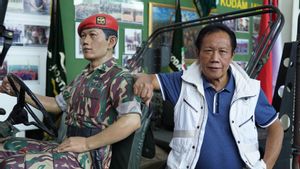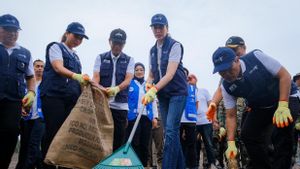JAKARTA - The long dry season often invites all kinds of disease outbreaks in Batavia (now: Jakarta). This condition occurred because the Dutch colonialists ignored the environment. The death rate increased. Likewise with those who fell ill.
The colonial government of the Dutch East Indies did not remain silent. They perpetuate all kinds of ways. In fact, the Dutch considered the phenomenon of dust enveloping Batavia as a medium for the development of disease. The option of spraying the streets was then chosen as the main choice.
Perhaps the advantage is the earliest word present in the Dutch colonial dictionary. This greedy attitude made them perpetuate all means to make a profit. The clearing of land for rice fields and plantations in Batavia became an assessment.
Surprisingly the Dutch trading airline, the VOC always felt insufficient. Compemi then seek additional income through the granting of permits to build factories. From arical distillation factories, opium (opium), tomission. The action in fact brought new problems.
It's like what language you plant that you reap. The Company was forced to surrender to the presence of the 'colera and malaria' plague in Batavia. The entire epidemic spread blindly throughout Batavia. Mainly, when the dry season arrives.
The Company did not remain silent. They tried to inflame the disease outbreak. All kinds of studies were tried. However, Kompeni's actions half-heartedly destroyed everything. The death rate also increased.
This condition made the hospital and funeral like a race to be full. The problem of disease outbreaks was never resolved when the Company was replaced by the colonial government of the Dutch East Indies. The power-owner began to suspect Batavia, who was covered in dust, as the source of the spread of the pandemic.
This condition is considered reasonable because many roads in Batavia were not paved in the 1900s. The desire to build many paved roads was then echoed by all Batavians to reduce dust.
Mobil di zaman kita adalah kendaraan yang paling tercintai oleh para pentinggi dan kapitang. Sekarang ini, tentu saja, apa yang dianggap paling kuasa, dan ke arah mana semua kekuatan dan semua waktu dihabiskan, adalah perbaikan jalan. Jalan-jalan besar menjadi lebih baik, lebih indah, lebih tejut, dan lebih tercerti setiap setiap hari.
Step by step as the road is plastered, coated with concrete and gravel in the most advanced way, gravel hills also grow. It is certain that it is about the future: even village roads and all village roads. There is no too small way to make it bigger, wider, more attractive, and more slippery, "explained Mr Marco Kartodicromo as quoted by Rudolf Mrazek in the book Engineers of Happy Land: Development of Technology and Nationalism in A Colonion (2006).
The colonial government of the Dutch East Indies has perpetuated the construction of a paved road in Batavia in the 1910s. The problem is only one. The development carried out is so limited. Instead of increasing the budget to make paved roads, the Dutch actually thought of cheaper solutions.
The morning watering agenda was chosen as a solution so that Batavia would not be dusty. The Dutch colonialists through the Batavia City Council then recruited the natives to become sprayers. They were then equipped with sprayers used to collect water in the Ciliwung River and sprayed the streets of Batavia.
Sprayers work like there are no holidays. They can only take a conditional vacation. First, Batavia is having rain, which means a day off. Second, the siram driver will take longer off when Batavia floods are big.
The number of siram drivers has also increased over time. Likewise with the equipment. In the 1920s, for example. Road spraying does not only use watering staff. The colonial government has involved trucks to help with the watering agenda.
The recitation was considered successful in reducing dust and disease outbreaks that did not develop in Batavia. Recently, the spraying of roads began to be abandoned by the Dutch colonialists. All because the paved roads began to appear throughout Batavia. The presence of the asphalt road made Jakarta no longer covered in dust such as unpaved roads.
The road dust zone in Batavia in addition to originating from the fertile low soil deposits also comes from volcanic ash from the eruption of Mount Krakatau in 1883. Apart from being poured with water, the road in Batavia was also doused with kerosene. Watering with this kerosene was only for a short time because it was stopped after the price of kerosene soared and felt sorry to throw it away.
The watering and cleaning of roads was carried out by Reinig-en Besproeiingsdienst or the Sanitation and Watering Service in the Gemeente Batavia area. In 1921 the agency had 15 garbage transport cars and seven cars for watering for each of the seven parts of the city. Other areas where there are no watering cars, still use human power or are doused by its own settlers," explained Zeffri Alkatiri in the book Jakarta Has Cara (2012).
SEE ALSO:
The English, Chinese, Japanese, Arabic, and French versions are automatically generated by the AI. So there may still be inaccuracies in translating, please always see Indonesian as our main language. (system supported by DigitalSiber.id)














